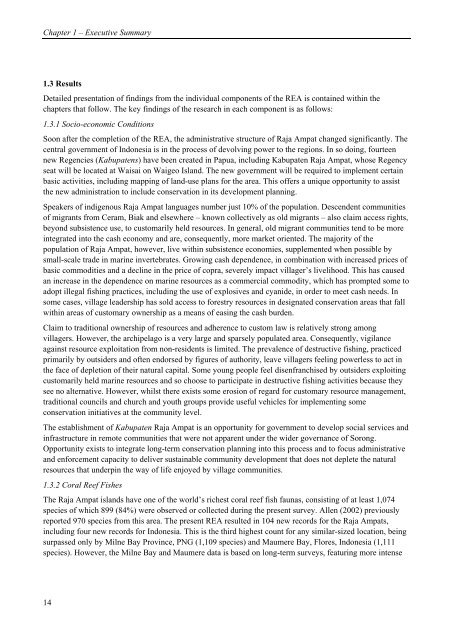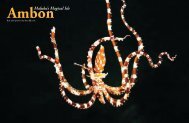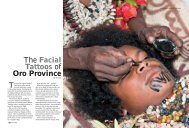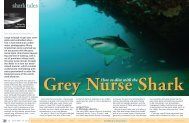Rapid Ecological Assessment - Indo-Pacific Images
Rapid Ecological Assessment - Indo-Pacific Images
Rapid Ecological Assessment - Indo-Pacific Images
- No tags were found...
Create successful ePaper yourself
Turn your PDF publications into a flip-book with our unique Google optimized e-Paper software.
Chapter 1 – Executive Summary<br />
1.3 Results<br />
Detailed presentation of findings from the individual components of the REA is contained within the<br />
chapters that follow. The key findings of the research in each component is as follows:<br />
1.3.1 Socio-economic Conditions<br />
Soon after the completion of the REA, the administrative structure of Raja Ampat changed significantly. The<br />
central government of <strong>Indo</strong>nesia is in the process of devolving power to the regions. In so doing, fourteen<br />
new Regencies (Kabupatens) have been created in Papua, including Kabupaten Raja Ampat, whose Regency<br />
seat will be located at Waisai on Waigeo Island. The new government will be required to implement certain<br />
basic activities, including mapping of land-use plans for the area. This offers a unique opportunity to assist<br />
the new administration to include conservation in its development planning.<br />
Speakers of indigenous Raja Ampat languages number just 10% of the population. Descendent communities<br />
of migrants from Ceram, Biak and elsewhere – known collectively as old migrants – also claim access rights,<br />
beyond subsistence use, to customarily held resources. In general, old migrant communities tend to be more<br />
integrated into the cash economy and are, consequently, more market oriented. The majority of the<br />
population of Raja Ampat, however, live within subsistence economies, supplemented when possible by<br />
small-scale trade in marine invertebrates. Growing cash dependence, in combination with increased prices of<br />
basic commodities and a decline in the price of copra, severely impact villager’s livelihood. This has caused<br />
an increase in the dependence on marine resources as a commercial commodity, which has prompted some to<br />
adopt illegal fishing practices, including the use of explosives and cyanide, in order to meet cash needs. In<br />
some cases, village leadership has sold access to forestry resources in designated conservation areas that fall<br />
within areas of customary ownership as a means of easing the cash burden.<br />
Claim to traditional ownership of resources and adherence to custom law is relatively strong among<br />
villagers. However, the archipelago is a very large and sparsely populated area. Consequently, vigilance<br />
against resource exploitation from non-residents is limited. The prevalence of destructive fishing, practiced<br />
primarily by outsiders and often endorsed by figures of authority, leave villagers feeling powerless to act in<br />
the face of depletion of their natural capital. Some young people feel disenfranchised by outsiders exploiting<br />
customarily held marine resources and so choose to participate in destructive fishing activities because they<br />
see no alternative. However, whilst there exists some erosion of regard for customary resource management,<br />
traditional councils and church and youth groups provide useful vehicles for implementing some<br />
conservation initiatives at the community level.<br />
The establishment of Kabupaten Raja Ampat is an opportunity for government to develop social services and<br />
infrastructure in remote communities that were not apparent under the wider governance of Sorong.<br />
Opportunity exists to integrate long-term conservation planning into this process and to focus administrative<br />
and enforcement capacity to deliver sustainable community development that does not deplete the natural<br />
resources that underpin the way of life enjoyed by village communities.<br />
1.3.2 Coral Reef Fishes<br />
The Raja Ampat islands have one of the world’s richest coral reef fish faunas, consisting of at least 1,074<br />
species of which 899 (84%) were observed or collected during the present survey. Allen (2002) previously<br />
reported 970 species from this area. The present REA resulted in 104 new records for the Raja Ampats,<br />
including four new records for <strong>Indo</strong>nesia. This is the third highest count for any similar-sized location, being<br />
surpassed only by Milne Bay Province, PNG (1,109 species) and Maumere Bay, Flores, <strong>Indo</strong>nesia (1,111<br />
species). However, the Milne Bay and Maumere data is based on long-term surveys, featuring more intense<br />
14





